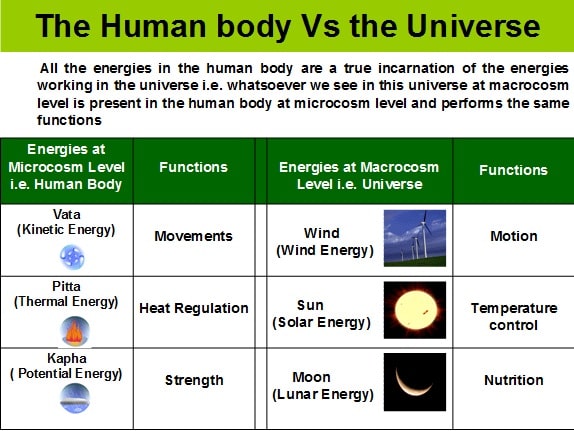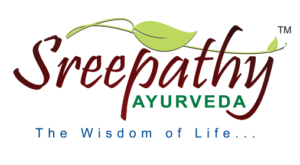Philosophy of Ayurveda
The philosophy of Ayurveda is natural, as it considers nature as the prime aspect of life. Inspect of diversity of everything, it is unitary in action and effect. The various articles of food, if analyzed, can be understood to contain various ingredients with diverse properties and particulars, but as food, the action is unitary in sustaining and maintaining the systems. The human body has various organs each with particular functions and aspects, in maintaining particular system. But the system as a whole is the holistic effect of all the particular systems properly working. The lungs, the heart, the liver, the kidneys etc. have particular functions, but they collectively work in providing and maintaining the cumulative effect, health. For the efficient working of the whole system, each particular system has to work efficiently, coordinating and co-operating. This is the concept of health, in Ayurveda. In disease a particular organ or system is out of order and it disturbs cooperative functioning of all the organs and systems. All these depend on the style, and conditions and circumstances of life. When something is wrong some where, the balance is lost, where the other things also automatically fail, resulting in disease. So treatment is corrective in nature in the style and circumstances of life.
Any set of medication assists nature in its curative effect. Even without medicine sometimes, disease may be cured by correcting the lifestyle but never with medicine along. Particular disease may seem to be ameliorating by medicine, but the morbid condition of the system remains, ensuring disease in the some or other form. At times it may be in a more severe form, as a result of the deceased vitality caused by the previous disease, and medicines used, as the faults of life style remains. The experience in formulating the strategies for ‘Health for all in 2000 AD’ clearly indicates this. The effort was to provide effective medicine, to all patients even in the remotest areas of the State. The effort was disease oriented. The result was more disease, more serious in nature, as that primary cause of all diseases; the defective life style was not at all taken into consideration. The treatment has to be health oriented, providing the basics of a healthy life, corrected life style, medicine just to assist the system in its process of returning to its natural condition of health. That is the basic approach of Ayurveda. It is said in the texts, that it is the cause of health and disease, life styles, proper for health and improper for disease. In health every system of the body functions properly, maintaining the balance of all the biological aspects of the system, manifesting ‘symptoms’ of well being. In disease some particular system is affected, upsetting the balance of the whole system, manifesting particular symptoms of uneasiness, differentiating particular disease.

The world view
We understand the world around us through our senses, hearing, touching, seeing, testing and smelling. Each sense grasps one quality (guna) sound etc. The qualities cannot exist independently. Each quality has its own matter (dravya). As we have five senses, there has to be five basic qualities (gunas) and five kinds of basic matters (dravyas). These primary aspects of matter are called bhoothas. The bhoothas combine to from the various subjects of the universe. As all objects can be heard, touched, seen, tasted and smelt, they are said to be composed of the five bhoothas, the difference in sound produced etc. is due to the difference in the proportion and arrangement of the bhoothas, in the composition of the particular object. In some object some quality may be latent, not grasped by the particular sense organ, for example, gold is not smelt or tasted. But as the properties ascribed to the bhoothas, which have smell and taste also are evident, when gold is processed and used as medicine, with its benefits. So it is reasoned that it is composed of those bhoothas also.
The primary thing is that the particular properties of the various objects to be used as food and medicine have to be properly understood for effective and beneficial application. These are explained in the texts as to what are what, and which is which. The question how is also explained, but the question ‘why’ is tried to be explained by reasoning which may cause differences in opinions. The primary thing to be known of a raw material is how they act and what do they effect in the system when applied as food and medicine. This kind of knowledge can be gained only by observation, and experiments. The texts codify the practical and theoretical knowledge obtained and verified through the ages. Whatever said in the texts is vouched even today. It is not the disease and its medicine. Treatment is actually rectifying the morbid condition, condition of the system caused by unhealthy habits and circumstances of life. By adhering to healthy life style, in diet and habits the disease denoting the morbid condition is primarily cured. Medicine and treatment assist the system to regain its normal condition. The problem with modern day treatment is the undue importance given to medicine, neglecting the aspects of life style. We can see the programme, Health for all by 2000 AD failed, as we see today, to achieve the goal, because the question of life style was ignored and medicine is given all the importance. Health is the result of proper psychic conditions also, perhaps even more than the physical conditions and that aspect was also disregarded. The amelioration of the symptoms was considered to the cure of disease. It was forgotten in actual practice that the symptoms are not the disease; they just indicate that something is wrong in the system. By medicine, the symptoms can be suppressed, but only by correcting the style and circumstances of life, the system can be functionally and structurally corrected, ensuring health.
Ayurveda has its theory on the working of the system. If we analayse the biological aspects of the system, each and every tissue of the body, is disintegrated and reintegrated. The various internal organs cooperate in their way in this process of disintegration and integration. There has to be a coordinating factor in all the processes, controlling the various functions in this regard. These three basic aspects of sustaining and maintaining the system are technically termed doshas. The word dosha has a two-fold meaning, that which instigates proper function in proper conditions of life, and that pollutes the tissue and disturbs the various functions of the various systems of the “system”. In proper life style, the instigation of the doshas ensures health. When the conditions of life changes and is improper, the instigation changes, the balance of the system is lost leading to disease. The manifestation, health as well as disease, brings out various symptoms, which denote the prevailing conditions. The symptoms of health denote ease, pleasantness mentally and physically. In disease, as the term itself denotes, the ease is lost and symptoms indicate unpleasantness, pain. In health, we forget that there is a body, as everything is natural. In health, we do not actually feel that we are breathing or seeing. In disease, when the process of breathing is disturbed, we feel it as symptoms of pain, blurred vision, smelling etc. Then we think of the eyes, think of taking remedy. This is because health is natural, and disease is unnatural and artificial conditions of life, that too instinctively, begets disease.

The treatment in Ayurveda is essentially to regain the vital strength and then the accumulated waste has to be eliminated to make the dhathus pure. If the accumulation is too much, it has to be cleared by evacuative treatments, sodhana chikitsa, known as panchakarma. If it is not so much, it can be transformed by medicine, and is be easily eliminated in the natural course of the system by treatments known as samana chikitsa. Samana chikitsa ignites the vital fire, the agni, performing digestion and metabolism. A man with good and natural digestive functions with a correct life style seldom gets diseased, and if by clearance of omissions and commissions, gets diseased, it can be easily corrected and, cured with some simple medication. It is in essence the Ayurvedic approach to health and disease. The virus, bacteria etc. will fail to act in such a constitution, will get digested and eliminated in the course of digestion and metabolism, and in certain persons, they remain to some period, but without being able to do any havoc in the system, such persons are called carriers. They too naturally perish, in course of time, the systemic conditions being unfavorable for their existence.
The treatment with medicines is yukthivyapasraya, the rational application of drugs. There is a branch of medicine, with repentance, invoking the blessings of the Gods. Ayurveda considers sin, ‘papa’ as the basic cause for all kinds of sufferings. Primarily sin is the result of certain actions, which we have done previously with faulty intension, causing harm to other people, at times not performing our duties. The papa need not be committed in the present birth; it may be in a previous birth. Ayurveda accepts the theory of rebirth, to sustain the concept that every effect has to have its particular cause. Various kinds of prayer and propitiations of the Gods are presented in the texts to ameliorate sin. Texts elucidated sins as three fold, with deeds, words and thoughts, which are all inclusive of life. Virtue (punya) is the primary cause of all happiness. Sin hinders discretion, as a result of which good and bad are not differentiated, ensuing harmful changes occur in the life style. A perturbed mind disturbs the mechanism of the proper working of the system, which results in disease. The opposite is the case of virtue, (punya), which results in health. To achieve, maintain, and regain happiness in the form of health, one has to be essentially virtuous in all aspects of life.
The third aspect of treatment is the control of the mind. Agitated mind agitates all aspects of the whole system. Without a calm and quite mind, the intellect will not function properly, which results in indiscretion, discerning the bad and the good. Association with good and wise people, reading good books, scriptural texts, practicing methods of controlling the mind, meditation, discrimination etc. assist in controlling the mind. We can see that Ayurveda is perhaps the only system of medicine where all these aspects of life are clearly explained and advised in maintaining health and curing diseases. It makes the system of Ayurveda truly holistic, compressing all aspects of practical life and living. The trend in modern medicine, even in modern ayurveda which tries to imitate modern medicine in the name of science usually adhere only to the medicinal aspects of treatment, ignoring perhaps the more important other two aspects. For the medicinal aspects to be essentially successful, the other two aspects have to be thoroughly comprehended and basically applied. Ayurveda is said to eternal because of its holistic approach, which is natural in natural conditions. Against nature nothing will persevere; that is the lesson of history.
The theories and practices of Ayurveda strictly adhere to the laws of nature. The panchabhootha theory is derived from the laws of nature with regard to the structural aspects of the substance, used as food and medicine. Tridosha theory is mainly derived from the functional aspects of the system in response to the conditions and circumstances of life. The plants from which the drugs are obtained, also germinate grow and perish in their circumstance. The thridoshasiddhantta can be applied to explain these phenomena. The body has its own structure, which has to be explained from the standpoint of the panchabhootha theory. Even the doshas, the basic functional units of the system are explained as constituted of the bhoothas. So we can find that the theories and practices of Ayurveda all pervasive in nature. In spite of many historical reasons and even ceturies of neglect Ayurveda still exists with practitioners of the old generations, like me with no knowledge of the modern methods of diagnosis and practices, curing many a time, even the diseases not cured by the expert treatments of the modern medicine. Advanced researches in ayurveda are being carried out through out the civilized and scientifically advanced countries of the world. Medicines can be mostly from herbs naturally available. The processes of preparing medicine are mostly like that of food items. In Ayurveda, health is natural food is natural, disease is natural, and medicine also is natural in their given conditions. The natural life style naturally promotes health, while unnatural life style also naturally promotes disease. So to cure disease and regain health, the main thing to do is mainly to correct the life style, medicine is just a helping hand or hasthalamba as the word is used in the texts. This is perhaps a common sense view of the whole problem. Bereft of commonsense, the explanations will not be easily and correctly comprehended. And it is perhaps the traditional view. In addition it is actually the outcome of the experiences and experiments of centuries. So if properly understood and applied, for times yet to come it will serve its purpose of sustaining and maintaining health. Any system of treatment, entirely ignoring these fundamental aspects of life and nature, cannot succeed in its fundamentals purpose, as is evident from the conditions of modern society, which is said to be with less mortality but with more morbidity. Mortality is less because of advances made in emergency management with advances made in surgery particularly. Morbidity is more are to the neglect in respect to life style–eating, exercising, resting, sexual matters, moral aspects, reacting, thinking, sense pleasures, controlling emotion etc.. Particularly in indulging in bad habits like drinking, smoking, using narcotics, with paying scant attention to these matters with highly powerful medicines applied weakening the immune system. In modern medicine, it seems, more stress is given to medicine, without much importance to these kinds of harmful habits, which actually is the basis of disease, making the system as whole, vulnerable to disease. It is said that many modern diseases are iatrogenic in origin, caused by medicine. With a little common sense most of problems of health can be avoided and solved. The strength of Ayurveda which has a common sense view of treatment, is the emphasis given to avoid all these bad habits of life, to ensure good habits, as prescribed regimen as a part of treatment (pathya). Pathya is avoiding habits inimical to the system ensuring habits conducive to health. Then medicines logically selected and applied; work properly and easily, correcting the metabolic and other aberrations of the system. In Ayurveda cure is not enforced by treatment, but induced from inside, endogenic.
It is recorded history that even up to surgery according to Ayurveda, was being practiced in various parts of India. During the period of about two hundred years of British rule, Ayurveda was neglected and modern medicine was encouraged in every way. But something of the original, Ayurveda, still remains in practices, because of its benefits, and even that works wonders, many a time. In the course of history, many good practices vanished in the current of change, but at times, nothing better does take shape. In the case of Ayurveda there is a chance of resurrection, as it has not thoroughly vanished, and as a thoroughly better system has not emerged. So from what has remained, with proper understanding and application, a revival is possible now, we see a general change in the attitude of the people. There is a trend in the higher level of scientists to turn to traditional systems as alternative medicine. The thought of alternative arises when the prevalent system fails to meet the challenges of life. So I think, there is real hope for the revival of ayurveda, in a better shape to meet the challenges of modern life.
Book an Online Consultation with Dr.Siju Muraleedharan
Get Authentic Ayurveda Treatments For A Healthy Life.
Important Links
- About us
- Online Consultation
- Privacy Policy
- Terms & Conditions
- Shipping and Refund
Our Location
- Sreepathy Ayurveda Clinic, Near Mahadeva Temple, Kovilpadam Road, Ettumanoor, Kerala, India 686631
- doctorsiju@gmail.com
- +91 6238 110 306
Join Our Facebook Group
Join our Facebook Group to learn and discuss about ayurveda.
© Copyright 2023 Sreepathy Ayurvedam All Right Reserved.

